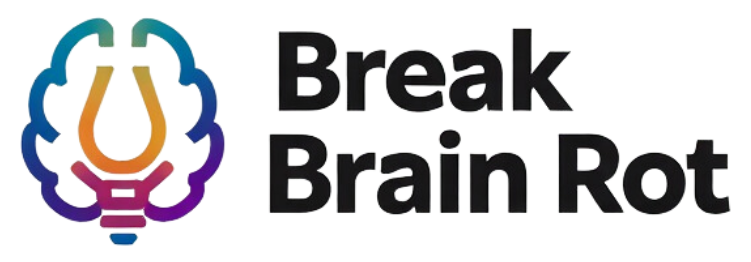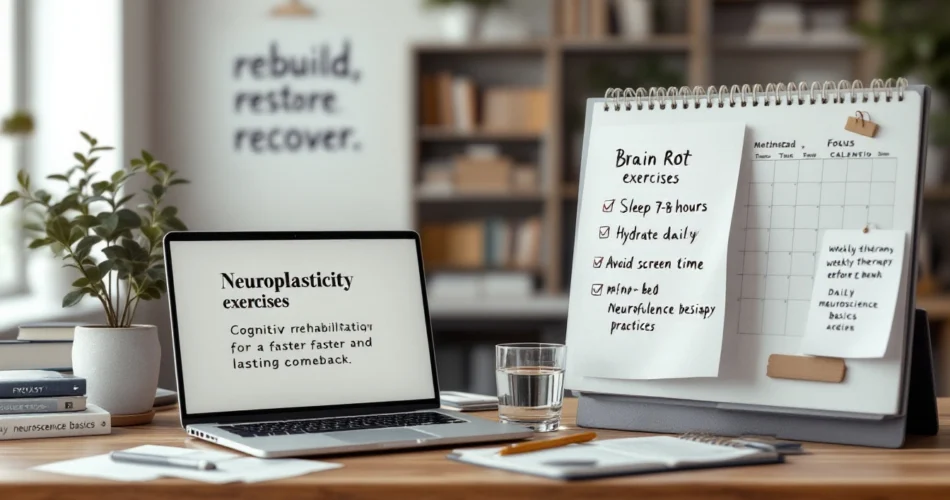1. **Analyze the article title and focus keyword:**
– **Title:** “Brain Rot Recovery Tips for a Faster and Lasting Comeback” — implies action, recovery, and sustainable improvement.
– **Focus Keyword:** *brain rot recovery tips*
– **Synonyms & Related Terms:**
– Overcoming digital burnout
– Mental fatigue recovery
– Detoxing your brain
– Focus restoration
– Digital addiction recovery
– **Keyword Variations:**
1. Tips for brain rot recovery
2. How to recover from brain rot
3. Brain rot recovery guide
4. Recovering from brain rot fast
5. Effective brain rot recovery methods
6. Brain rot treatment tips
7. Steps for brain rot recovery
2. **Review the outline and plan article structure:**
– **Main Sections & Subsections:**
1. Understanding Brain Rot and Its Impact (200 words)
– What Is Brain Rot?
– Causes of Brain Rot
– The Mental and Physical Effects
2. Early Warning Signs (150 words)
– Behavioral Shifts
– Emotional Symptoms
– Sleep and Routine Effects
3. Proven Brain Rot Recovery Tips (300 words)
– Digital Detox Strategies
– Attention Reclaiming Techniques
– Physical & Mental Wellness
4. Building a Sustainable Routine (200 words)
– Healthy Tech Boundaries
– Brain-Enhancing Habits
– Tracking Progress
5. Reigniting Focus & Motivation (200 words)
– Goals & Intentions
– Cognitive Training
– Accountability & Community
6. FAQs (100–150 words)
7. Conclusion (100–150 words)
– **Flow:**
From understanding to recognition → actionable recovery → routine building → sustaining focus → FAQs and closing motivation.
3. **Brainstorm secondary keywords:**
– restore focus naturally
– overcome digital overload
– mental clarity practices
– attention span recovery
– cognitive reboot
– digital detox for mental clarity
– improve concentration habits
– reduce screen fatigue
– mindfulness techniques for focus
– productivity revival
4. **Plan the introduction and conclusion:**
– **Introduction:**
– Start with relatable experience of mind-numbing scrolling
– Define brain rot and why it matters
– Mention “brain rot recovery tips” early
– Preview article structure
– **Conclusion:**
– Reinforce recovery as marathon, not sprint
– Review key strategies briefly
– End with motivational CTA encouraging consistent small changes
5. **Generate potential FAQ questions:**
– What are the fastest brain rot recovery tips?
– How can I tell if I have brain rot?
– Can exercise improve brain rot recovery?
– How long does recovery from brain rot take?
– Is brain rot a real condition?
– Are digital detoxes enough to reverse brain rot?
– How can I maintain progress long-term?
– What foods help brain function recovery?
6. **Keyword incorporation strategy:**
– Use *brain rot recovery tips* in:
– Introduction paragraph
– Section 3 title and first paragraph
– Conclusion
– Use *brain rot recovery* and secondary terms throughout related segments.
– Include focus keyword 6–8 times naturally.
7. **Content outline with hooks:**
– **Section 1:** Hook with “Have you felt your brain glaze over after endless scrolling?”
– **Section 2:** “Before burnout hits, these signs will warn you.”
– **Section 3:** “Actionable, research-backed brain rot recovery tips you can start today.”
– **Section 4:** “Long-term resilience is built through habits, not hacks.”
– **Section 5:** “Once you’re out of the slump — here’s how to stay sharp.”
– Balance sections 150–300 words depending on depth.
8. **Internal linking strategy:**
– Link to related posts or resources:
1. *How to Limit Screen Time Effectively* (#internal-link1)
2. *7-Day Digital Detox Challenge* (#internal-link2)
3. *Morning Routines That Boost Productivity* (#internal-link3)
4. *Online Communities for Personal Growth* (#internal-link4)
– Integrate naturally based on topic relevance in relevant sections.
9. **Potential reader challenges & responses:**
– “I can’t avoid my phone for work.” → Suggest balance and dedicated no-screen zones.
– “I don’t know where to start.” → Start small, one recovery habit per week.
– “I always relapse into scrolling.” → Add accountability, habit tracking.
– “Is this even real?” → Backed by psychology research; link credible sources.
– “I feel overwhelmed.” → Emphasize mindset over perfection.
Have you ever felt your mind go foggy after a day of endless scrolling or binge-watching short videos? You’re not alone. In our hyper-connected world, this phenomenon — often called “brain rot” — leaves many feeling mentally drained and unable to focus. Luckily, there are practical brain rot recovery tips you can apply to get your focus and creativity back. In this article, you’ll discover what causes brain rot, how to recognize the signs, and the most effective ways to recover for good.
Table of Contents
- Understanding Brain Rot and Its Impact
- Early Warning Signs You Might Be Experiencing Brain Rot
- Proven Brain Rot Recovery Tips for a Faster Comeback
- Building a Sustainable Routine for Long-Term Recovery
- Reigniting Focus and Motivation After Recovery
- FAQs
- Conclusion
Understanding Brain Rot and Its Impact
What Is Brain Rot?
“Brain rot” is a slang term describing cognitive fatigue from digital overstimulation — the endless consumption of social media, videos, and low-effort content. It’s not a clinical diagnosis, but it captures the sensation of feeling scattered, unmotivated, and mentally dull. According to Psychology Today, digital overload can impair concentration and short-term memory.
Causes of Brain Rot
Common causes include excessive screen time, multitasking, and constant dopamine hits from notifications. Without mental “quiet time,” your brain’s ability for deep work declines. Creating intentional focus blocks and learning how to limit screen time effectively can make a huge difference in recovery.
The Mental and Physical Effects
Brain rot doesn’t just affect your thoughts — it can drain your physical energy. Symptoms may include fatigue, memory lapses, anxiety, and disrupted sleep. The more you consume without reflection, the harder it becomes to engage in meaningful creation or problem-solving.

Early Warning Signs You Might Be Experiencing Brain Rot
Recognizing Behavioral Shifts
You know you’re slipping into brain rot when you struggle to focus, procrastinate often, or scroll aimlessly even when you don’t enjoy it. These behaviors replace active engagement with passive consumption.
Emotional Symptoms
Low motivation, irritability, and a constant sense of boredom despite stimulation are emotional indicators. You might crave distraction because your brain has become addicted to novelty instead of depth.
The Role of Sleep and Routine
Exposure to screens late at night delays melatonin production, making it harder to fall asleep. According to the Sleep Foundation, even subtle sleep deprivation worsens attention span and emotional regulation, deepening the effects of brain rot.
Proven Brain Rot Recovery Tips for a Faster Comeback
Digital Detox Strategies
A digital detox doesn’t require you to abandon technology altogether. Instead, set boundaries. Schedule “screen-free” hours daily — perhaps during meals and an hour before bed. Curate your feed to follow content that educates or inspires you. If you need structure, try this 7-Day Digital Detox Challenge to reset your habits.
Reclaiming Your Attention Span
Rebuilding focus takes consistent training. Practice mindfulness by observing thoughts without judgment. Read long-form content to reengage your deep-thinking circuits. Tools of digital minimalism — like disabling notifications or keeping your phone in another room — promote clarity and restore calm attention.
Physical and Mental Wellness
Physical health directly influences mental recovery. Exercise improves cerebral blood flow and endorphin balance. Hydration and nutrient-rich meals sustain brain energy. As Harvard Health suggests, even moderate activity boosts cognitive performance over time.
Building a Sustainable Routine for Long-Term Recovery
Creating Healthy Boundaries with Technology
Balance is key. Use tools like time-blocking apps to assign clear periods for work, rest, and play. Track how much time you spend online and assess the value each activity brings. Setting screen-free rituals, like a morning walk or journaling session, gives your brain space to recharge.
Cultivating Brain-Enhancing Habits
Habits such as meditation, journaling, or pursuing an offline hobby foster creativity and presence. Building consistency matters more than intensity. Incorporate these ideas into your day using proven strategies from morning routines that boost productivity.
Tracking Progress Over Time
Monitor subtle changes — better focus, improved mood, or increased enjoyment in quiet moments. Journals or habit-tracking apps can help measure progress and keep motivation high as your brain rot recovery deepens.
Reigniting Focus and Motivation After Recovery
Setting Clear Goals and Intentions
Once you feel mentally lighter, define what “focused living” means for you. Reconnect with your core goals — whether that’s learning new skills, growing your career, or reconnecting with loved ones. Small, clear intentions help sustain growth.
Cognitive Training and Skill Development
Feed your brain new challenges: pick up reading again, learn a language, or engage in creative projects that stretch your cognitive limits. Research like the Stanford Neuroplasticity Study shows our brains adapt beautifully when exposed to intentional learning.
Community and Accountability
Surround yourself with people who share your growth mindset. Join productivity or mindfulness communities such as online communities for personal growth. Accountability keeps you on track and transforms recovery into a shared journey.
Frequently Asked Questions
What are the most effective brain rot recovery tips for beginners?
Start with small changes: schedule digital breaks, prioritize 7–8 hours of sleep, and engage in one creative or physical activity daily.
How long does it take to recover from brain rot?
It varies, but noticeable improvements often appear after 2–3 weeks of consistent practice. Sustained focus comes with long-term habit building.
Can digital detox alone cure brain rot?
Not entirely. Detoxing helps, but lifestyle changes like exercise, reading, and mindfulness create lasting recovery.
What foods help with brain rot recovery?
Opt for omega-3-rich foods (salmon, flaxseed) and antioxidant sources like blueberries to support brain health.
Is brain rot a medical condition?
No, it’s an informal term for cognitive fatigue caused by overstimulation. However, it’s a real and relatable challenge of the digital era.
Conclusion
Recovering from brain rot is less about instant fixes and more about consistent action. By applying these brain rot recovery tips — digital detoxing, focus training, and balanced routines — you can reclaim your time, creativity, and joy. Remember: the path to lasting mental clarity begins with one mindful choice today. Start small, stay steady, and enjoy your comeback to focused living.


